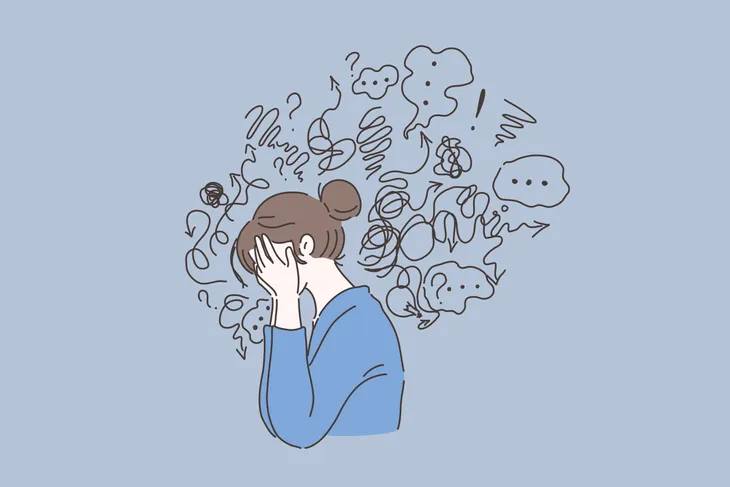- Maladaptive dreaming is when people spend long periods of time in structured daydreams or fantasies.
- Symptoms include vivid, immersive, and long daydreams that are hard to escape. An inability to be productive, insomnia, and unconscious movements when daydreaming.
- They’re often triggered by specific events, a picture, movie, or news story, sensory stimuli, internet use, etc.
- There is no treatment, but may be managed with better sleep, therapy, identify and avoid triggers, and informing oneself and others of the potential symptoms.
We’ve all been there before, likely during a long day at school or work. You drift off into a daydream about something, anything more interesting. Maybe it’s about being on vacation, a high school crush, or just what it would be like to be someone else. You’re pulled back to reality a few moments later and carry on. This type of behavior is totally normal and nothing to be concerned about.
While daydreaming is often harmless, maladaptive daydreaming can have a hugely negative impact on a person’s life. While it’s not recognized as an official medical condition, most healthcare professionals are familiar with it. To learn more about this condition, here’s a look into what maladaptive dreaming is, the symptoms, causes, and potential treatment options…
What is Maladaptive Dreaming?
Maladaptive dreaming is essentially daydreaming, but a much more intense version of it. People with this condition will spend long periods of time engaged in these daydream fantasies and have trouble focusing or engaging in their real life. It can have a serious impact on their daily life, particularly their productivity at work or in school, says Healthline.
According to Healthline, the condition is relatively new. It was first described in 2002 by professor Eliezer Somer of the University of Haifa in Israel. There is still a lot of unknown surrounding maladaptive dreaming, but it does share some features with behavioral addictions like gaming or alcohol. These daydreams can be triggered by certain events like a specific topic of conversation, picture, movie or news story, internet use, sensory stimuli, and physical experiences.
Currently, there is no official diagnosis for maladaptive dreaming, and Healthline states that it does not have a category in the Diagnostic and Statistical Manual of Mental Disorders (DSM-5).
Symptoms
Since maladaptive dreaming is not a medical condition, there isn’t a set list of specific symptoms. However, according to Medical News Today if a person is experiencing this condition, they might experience one or more of the following symptoms…
- Highly vivid and immerse daydreams
- Abnormally long daydreams that are hard to escape
- Daydreams triggered by external events or stimuli (i.e. watching a movie or listening to music)
- Inability to carry out daily tasks
- Sleep disruption and insomnia
- Repetitive and unconscious movements when daydreaming (i.e. rocking back and forth or twitching)
Other possible symptoms are those commonly seen in attention deficit hyperactivity disorder, such as a short attention span, notes the source.
How a Person Feels
Many people who struggle with maladaptive daydreaming have negative feelings associated with their condition. This likely stems from the affect it has on their life, explains the Cleveland Clinic.
It can be a disruption in social activities by causing them to spend more time alone than with others. It can interfere with their work, hobbies, and other goals in life. There’s a lot of shame and guilt around it because of its interference, and in some ways it can be like an addiction. According to Cleveland Clinic there’s a compulsion around it and “if they don’t have the chance to do so, they may feel upset that they missed the opportunity to do it.”
Who Does it Affect?
It tends to occur more frequently in people with mental health conditions or certain types of brain functions, says Cleveland Clinic. The conditions commonly associated with maladaptive daydreaming are: attention deficit hyperactivity disorder (ADHD), anxiety disorders, types of depression, dissociative disorders, and obsessive-compulsive disorder (OCD).
Age can sometimes be a factor. For example, research suggests it’s more common in young adults and teenagers, and even children. However, the Cleveland Clinic warns that more research is necessary.
Cleveland Clinic also notes that many people affected by maladaptive daydreaming are those with a history of abuse or trauma, particularly during their childhood. Although this isn’t the case for everyone.
How Does it Affect the Body?
The affects of maladaptive daydreaming are mostly in the mind. Our minds are what contain unique memories, experiences, thoughts, beliefs, and emotions. This is different from the brain which is a physical part of the body and what generates all of these things, explains the Cleveland Clinic.
However, some experts believe maladaptive daydreaming does involve other aspects of the brain. “People with ADHD have small, but still important, differences in the size of certain parts of their brains,” writes the Cleveland Clinic. “Those areas are usually ones that control executive functions like decision-making, planning and self-motivation.”
In addition to this, the source points out that people with maladaptive daydreaming tend of have issues with executive dysfunction and trouble managing their emotions. Both of these present overlaps with ADHD, but the source notes more research is needed.
How Common is it?
As we mentioned earlier, it’s a relatively new concept that has only existed since 2002. As a result, there is not much research on the topic. This makes it hard to even guesstimate how common this issue is, says the Cleveland Clinic.
The source does refer to one early study which “put the number at 2.5-percent of adults in Israel, and slightly higher — about 4.3-percent — for younger adults who are students.” Another study found that it affects 20-percent of adults with ADHD which translates to 2.2 million adults in the U.S. This doesn’t take into consideration people with maladaptive daydreaming and not ADHD.
What Causes Maladaptive Dreaming?
It’s unclear why people experience maladaptive dreaming or why it happens to some people and not others. There have been some links made between this issue and other conditions. For example, Healthline points out that people with maladaptive dreaming may share features with those who engage in behavioral addictions like gaming. Healthline lists the following as some other potential causes…
- Feel the need to escape from real-life difficulties (i.e. social anxiety and childhood trauma)
- Use daydreaming to overcome problems that seem insurmountable
- Distressed about being unable to control the daydreaming
- Find it so rewarding it’s difficult to stop
- Have dissociative tendencies, like excessive focus on internal thoughts or mistrust of the senses
Can it Lead to Other Conditions?
According to Healthline there is no evidence that maladaptive dreaming leads to other conditions. However, the source does note it can be so severe that it impacts a person’s quality of life. It can cause problems with their ability to focus, be productive, manage real-life relationships, and there overall mental well-being.
While maladaptive dreaming doesn’t lead to other conditions, it’s sometimes reported alongside conditions like depression, anxiety disorders, post-traumatic stress disorder (PTSD), OCD, ADHD, borderline personality disorder, bipolar disorder, dissociative disorder, and psychosis, notes Healthline.
Maladaptive Daydreaming and ADHD
Experts have found links between maladaptive dreaming and ADHD. Healthline refers to a 2017 study examining 39 people with maladaptive dreaming. Their findings showed almost 77-percent of the participants had both conditions. This insinuates there may be a link between the two.
More recently, some experts expressed concern about seeing ADHD as only a behavioral issue and urged people to consider how it can affect a person’s internal life. “Once aspect of this internal presentation is maladaptive daydreaming, which can impact your productivity and motivation at school and in the workplace,” writes Healthline. According to the researchers it tends to impact females more than males.
How to Diagnose Maladaptive Dreaming
It can be hard to get a diagnosis for maladaptive dreaming because it’s not an official condition. Some healthcare providers might not diagnose it directly and there aren’t any diagnostic or lab tests that can be done to confirm a person has it, explains the Cleveland Clinic.
The source explains that some clinicians can find signs of maladaptive dreaming through questionnaires and diagnostic scales for other related conditions like OCD, ADHD, depression, anxiety, and dissociative disorders. “They can also directly use the Maladaptive Daydreaming Scale-16 (MDS-16), a set of questions that can show if a person is more likely to have this issue,” writes the source.
Treatment
Unfortunately, there is no official treatment for maladaptive dreaming. This might have to do with the fact that experts still don’t know what causes it. However, therapy and mediation might help. Healthline refers to a 2018 case study of a person who was able to reduce their daydreaming by 50-percent after undergoing 6 months of counselling therapy, including cognitive behavioral therapy and mindful meditation.
Healthline also notes some researchers have proposed a technique called exposure and response prevention (ERP) to help reduce maladaptive dreaming. This technique works to change the ends of story plots to make them unpleasant to the person. An older study from 2008 found a prescription commonly used for OCD was effective in helping one person manage their maladaptive daydreams.
The more researchers learn, the better they will be able to determine a definitive and effective treatment plan.
How to Manage Maladaptive Dreaming
Since there is no treatment for maladaptive daydreaming, the best thing to do is try and manage it. Medical News Today provides some techniques that may help based on anecdotal evidence. For example, reducing fatigue by increasing the amount of quality sleep they get each night. They should try to be aware of their symptoms, and inform others so they can help interrupt any daydreams.
Another important thing to do is identify and avoid triggers. You can try to identify triggers by keeping a diary of when it occurs. Lastly, try therapy and medication. Some therapeutic techniques like cognitive behavioral therapy can help expose underlying issues and may offer a coping strategy.















